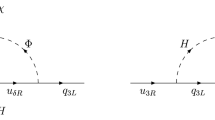Color has two facets in ► particle physics. One is as a three-valued charge degree of freedom, analogous to electric charge as a degree of freedom in electromagnetism. The other is as a ► gauge symmetry, analogous to the U(1) gauge theory of electromagnetism. Color as a three-valued charge degree of freedom was introduced by Oscar W. Greenberg [1] in 1964. Color as a gauge symmetry was introduced by Yoichiro Nambu [2] and by Moo Young Han and Yoichiro Nambu [3] in 1965. The union of the two contains the essential ingredients of ► Quantum Chromodynamics, QCD. The word “color” in this context is purely colloquial and has no connection with the the color that we see with our eyes in everyday life.
The theoretical and experimental background to the discovery of color centers around events in 1964. In 1964 Murray Gell-Mann [4] and George Zweig [5] independently proposed what are now called “quarks,” particles that are constituents of the observed strongly interacting particles, “hadrons,” such as protons and neutrons. Quarks gave a simple way to account for the ► quantum numbers of the hadrons. However quarks were paradoxical in that they had fractional values of their electric charges, but no such fractionally charged particles had been observed. Three “flavors” of quarks, up, down, and strange, were known at that time. The group SU(3)flavor, acting on these three flavors, gave an approximate symmetry that led to mass formulas for the hadrons constructed with these quarks. However the spin 1/2 of the quarks was not included in the model. (Quarks, see also ► Mixing and Oscillations of Particles; Particle Physics; Parton Model; QCD; QFT.)
Access this chapter
Tax calculation will be finalised at checkout
Purchases are for personal use only
Similar content being viewed by others
Literature
O.W. Greenberg: Spin and Unitary Spin Independence in a Paraquark Model of Baryons and Mesons. Phys. Rev. Lett. 13, 598–602 (1964)
Y. Nambu: A Systematics of Hadrons in Subnuclear Physics. In Preludes in Theoretical Physics, ed. A. de Shalit, H. Feshbach and L. Van Hove (North Holland, Amsterdam, 1966)
M.Y. Han and Y. Nambu: Three-Triplet Model with Double SU(3) Symmetry. Phys. Rev. 139, B1006–B1010 (1965)
M. Gell-Mann: A Schematic Model of Baryons and Mesons. Phys. Lett. 8, 214–215 (1964)
G. Zweig, CERN Reports 8182/TH.401 and 8419/TH.412 (1964). The latter is reprinted as An SU(3) Model for Strong Interaction Symmetry and Its Breaking. In Developments in the Quark Theory of Hadrons, ed. D.B. Lichtenberg and S.P. Rosen (Hadronic Press, Nonamtum, Mass., 1980)
F. Gürsey and L. Radicati: Spin and Unitary Spin Independence of Strong Interactions. Phys. Rev. Lett. 13, 173–175 (1964)
M.A.B. Bég, B.W. Lee and A. Pais: SU(6) and Electromagnetic Interactions. Phys. Rev. Lett. 13, 514–517, erratum 650 (1964) The magnetic moment ratio was found independently by B. Sakita: Electromagnetic Properties of Baryons in the Supermultiplet Scheme of Elementary Particles. Phys. Rev. Lett. 13, 643–646 (1964)
W. Pauli: The Connection between Spin and Statistics. Phys. Rev. 58, 716–722 (1940)
H. Harari, in 14th Int. Conf. on High-Energy Physics, ed. J. Prentki and J. Steinberger (CERN, Geneva, 1968)
O.W. Greenberg and D. Zwanziger: Saturation in Triplet Models of Hadrons. Phys. Rev. 150, 1177–1180 (1966)
D. Gross and F. Wilczek: Ultraviolet Behavior of Nonabelian Gauge Theories. Phys. Rev. Lett. 30, 1343–1346 (1973)
H.D. Politzer: Reliable Perturbative Results for Strong Interactions? Phys. Rev. Lett. 30, 1346–1349 (1973)
J.S. Trefil: From Atoms to Quarks (Scribner's, New York, 1980)
D. Griffiths: Introduction to Elementary Particles (Harper & Row, New York, 1987)
A. Watson: The Quantum Quark (Cambridge University Press, Cambridge, 2004)
A. Pais: Inward Bound: Of Matter and Forces in the Physical World, (Oxford, Oxford, 1986)
T.D. Lee: Particle Physics and Introduction to Field Theory (Harwood Academic Publishers, Chur, 1981)
O.W. Greenberg: Quarks. Ann. Rev. Nucl. Part. Sci. 28, 327–386 (1978)
Editor information
Editors and Affiliations
Rights and permissions
Copyright information
© 2009 Springer-Verlag Berlin Heidelberg
About this chapter
Cite this chapter
Greenberg, O.W. (2009). Color Charge Degree of Freedom in Particle Physics. In: Greenberger, D., Hentschel, K., Weinert, F. (eds) Compendium of Quantum Physics. Springer, Berlin, Heidelberg. https://doi.org/10.1007/978-3-540-70626-7_32
Download citation
DOI: https://doi.org/10.1007/978-3-540-70626-7_32
Published:
Publisher Name: Springer, Berlin, Heidelberg
Print ISBN: 978-3-540-70622-9
Online ISBN: 978-3-540-70626-7
eBook Packages: Physics and AstronomyPhysics and Astronomy (R0)



